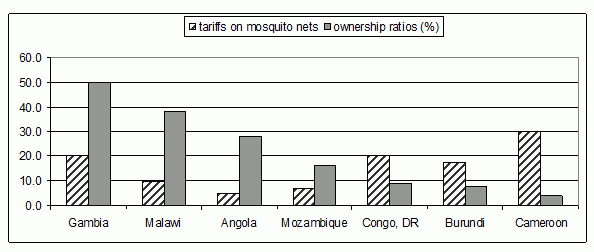"Sleeping with the enemy" is not just an adrenaline-raising movie starring Julia Roberts. In malaria-endemic countries, it is literally the challenge tens of millions of people have to deal with every day when they go to bed, particularly young children. According to the World Health Organisation (WHO), over 3 billion people are at risk of malaria. People living in Africa account for a vast proportion of them. Every year this leads to about 250 million malaria cases and nearly one million deaths, with 20% of child mortality directly linked to malaria or its consequences (WHO 2009).
Apart from being a public-health nightmare, malaria is also an economic handicap that leads to a vicious circle of poverty and illness. Gallup and Sachs (1998) estimate that countries where malaria is prevalent have an annual economic growth rate that is 1.3 percentage points lower than otherwise.
Nets and malaria
The global community has identified combating malaria as a key Millennium Development objective, and donors, including the WHO, other UN agencies, and NGOs such as the Bill and Melinda Gates Foundation, have made great strides in reducing the spread of this disease. The success is due to a combination of actions and measures, one of which is the increased use of insecticide-treated mosquito nets.
But the percentage of children using treated nets is still below targets, particularly in some of the largest African countries. For instance, according to UNICEF's ChildInfo programme, only around 6% of children under five years of age were sleeping under treated nets in Democratic Republic of Congo – one of the largest countries in Africa with more than 4 million cases of malaria.
While the rapid scale-up of treated-nets distribution in Africa represents an enormous public-health achievement, it also represents a formidable challenge for the future in ensuring that the high levels of coverage are maintained. The lifespan of a long-lasting treated net is currently estimated to be around 3-4 years. This means that millions of mosquito nets delivered in previous years are already, or will be soon due for replacement. Failure to replace these nets in time could lead to a resurgence of malaria cases and deaths.
What role can trade policy play in the fight against malaria?
At first sight one would argue that trade policy cannot be called upon to contribute directly to this important public-health challenge. Yet, trade policy was seen as one additional tool to fight malaria by African leaders. In April 2000, at the African Summit on Roll Back Malaria in Nigeria, 39 African countries have pledged to remove taxes and tariffs on insecticide-treated nets and other malaria-related preventive materials and drugs (WHO 2003).
This was hailed as a quick and effective contribution that trade policy could make towards the eradication of malaria in Africa. But, more than a decade later, it turns out that quite a few countries severely affected by malaria still maintain tariffs on the importation of mosquito nets and other malaria-fighting products and drugs.
According to the information provided by the Malaria Taxes and Tariffs Advocacy Project (a joint project sponsored by the WHO and Gates Foundation), in August 2010, some 30 countries in Africa still maintained tariffs as high as 20% on ITNs.
Imposing a tariff on a life-saving product can be tantamount to a "killer tariff" for some poor African households who would have to choose between food or other essential products and a more expensive mosquito net.
Over 100 million people are living in malaria-endemic countries that still apply a tariff on mosquito nets. For the top African countries with the highest number of reported malaria cases in 2010, tariffs on mosquito nets are still between 5% and 35% and the mosquito net ownership ratios are very low, except in Gambia. The correlation is not very strong since ownership ratios are in some countries largely determined by (duty) free distribution of mosquito nets by donors and international agencies.
Figure 1. Tariffs, malaria incidence and mosquito net ownership ratios
Sources: World Bank (WITS) for tariffs. WHO for malaria cases. UNICEF for mosquito net ownership ratios.
It should be noted that several countries (e.g. Kenya, Uganda, Senegal, Ghana, Nigeria) have taken the right steps and have eliminated tariffs on mosquito nets. Furthermore, countries like Nigeria, Ethiopia, and Madagascar have explicitly created several duty-free tariff lines for products including "mosquito net" in their descriptions (thus avoiding customs classification misunderstanding or abuse). Other countries have announced that, even if tariffs are still officially in place, they would waive the tariffs on mosquito nets.
But, as long as some double-digit tariffs persist, several malaria-endemic countries seem to import negligible amounts of mosquito nets in commercial terms, despite low coverage rates among vulnerable groups.
The cost of killer tariffs
To illustrate the potential direct contribution that trade policy in malaria-endemic countries could make to reduce malaria incidence, it would be important to estimate the positive health impact of removing tariffs on prices and availability of malaria bed nets. To estimate such impact the SMART model – a simple partial-equilibrium model developed by UNCTAD and the World Bank for trade policy analysis at detailed product level – is well-suited. Based on information on (i) initial import values of mosquito nets into malaria-endemic countries; (ii) their initial applied tariffs, and (iii) available elasticities that link supply and demand responses to price changes induced by the removal of tariffs1, the SMART model can estimate the increase in the value of additional mosquito nets imported.
The model is run on the sample of countries included in Figure 1, which account for about one third of malaria cases reported by the World Health Organization (WHO 2010). Identifying the HS code corresponding to mosquito nets was not obvious. In many countries the term "mosquito net" or a similar description that would allow an unequivocal customs classification, was not explicitly mentioned in their national tariff schedules2. However, after consulting several national tariff, it appears that mosquito nets are most often classified in the Harmonized System under HS6 560819. The information on whether a country actually applies a tariff on mosquito nets comes from a corroboration of WITS tariff data and a classification produced by the Malaria Taxes and Tariffs Advocacy Project based on detailed tariff data from the International Trade Centre in Geneva, a joint WTO-UNCTAD agency. The initial trade and tariff data comes from the World Bank-WITS project.
Based on these assumptions, using the SMART model to simulate the effect of removing tariffs ranging between 5%-30% on mosquito nets in the six African countries included in Figure 1 would lead to an increase in imports of around $300,000 essentially from China and Vietnam, by far the largest exporters of this product to Africa. The overall estimated increase in additional imports is very small when thinking about the millions and billions we usually see in international trade.
But this is not about the money. It is about the number of people that could be protected by the increased number of mosquito nets3. Based on several price estimates, if we consider that the average price of an insecticide-treated mosquito net is in the range of $5-$6, slashing tariffs on mosquito nets will allow some 50,000 households to acquire a potentially life-saving device for their children. The WHO estimates that on average a mosquito net is used by two children in a household. So, imposing tariffs on mosquito nets may have the unfortunate effect to deprive some 100,000 African children from having access to a life-saving product that could protect them from malaria – though this may well be an underestimate4.
Aid for Trade: Promoting stronger supply capacity in a coherent manner
Apart from promoting free trade in mosquito nets as a direct life-saving tool in Africa, several other international initiatives could play a positive role.
Aid for Trade, for instance, is a major effort aimed at fostering supply capacity and exports of goods and services from developing countries. While such efforts are primarily aimed at promoting exports, an interesting example illustrates how one could successfully address both domestic supply side constraints and promote regional trade in mosquito nets as well.
With the help of one NGO, UNICEF and several multinational companies having a key role in the production of long-lasting insecticide-treated nets have joined forces in establishing AtoZ Tanzania, a company that is described as one of Africa's largest manufacturer of long-lasting impregnated mosquito nets. The company is reported to have had access to the latest technology and could supply several African countries at a competitive price. This could be the long-term solution to aid dependency in Africa, when it comes to affordable access to mosquito nets all over Africa.
What is noteworthy is that AtoZ emerged as a competitive mosquito net regional provider without benefiting from the typical tariff protection of "infant industries": Tanzania has implemented a zero-tariff policy on mosquito nets. Such an example shows that protection is not necessary to build competitive industries. What is important is the coherence and partnership between various actors. It also calls for a coherent approach between donors, the private sector and the beneficiary country.
If the goal is to ensure that local African companies producing mosquito nets supply the domestic market at low prices and become a source of mosquito nets for other African countries, it would make little sense for instance to have double digit tariffs on imports of yarn, fibres and insecticides that are necessary to produce the mosquito nets.
Conclusions
In the end, what is clearly required is for trade, foreign direct investment, transfer of technology, and public-private partnerships to come together in a coherent way. Let us hope that the recently concluded Global Aid for Trade review in Geneva will identify and promote such coherence-enhancing priorities with Aid for Trade and other MDGs. Aid-for-Trade-sponsored training and technical assistance programmes aimed at African trade officials are well placed to "connect the dots" between public-health objectives and the importance of removing "killer tariffs" on malaria preventive material, and adopt other trade facilitation measures such as a dedicated tariff line for mosquito nets.
The prospects of one day malaria being nothing more than a horror story at bedtime for millions of children in Africa, instead of the killer it is today, depend on many factors but coherent trade policies could help bring that day a little bit closer.
Author's note: The views expressed herein are those of the author and do not necessarily reflect the views of the European Commission.
References
Gallup and Sachs (1998), “The economic burden of malaria”, Center for International Development at Harvard.
World Health Organization (2003), “The Abuja Declaration and the Plan of Action”, Geneva.
World Health Organization (2009) , "10 facts about malaria", March, Geneva.
World Health Organization (2010), World Malaria Report 2010, Geneva.
1 The default elasticities provided by the SMART model were used. However, a more precise analysis would require the use of mosquito net-specific trade elasticities. For a poor African household the actual price elasticity might be much higher than the default ones in WITS, thus leading to an underestimate of trade effects.
2 In a small number of cases (e.g. Nigeria, Ethiopia) mosquito nets were also classified under several tariff lines in HS chapter 56, 58 and 63.
3 The effective rate of protection and the import-dettering effect for a commercially imported mosquito net has to take into account the total price difference between the price increase induced by the tariff and the cost of obtaining a mosquito net from other sources (including UN agencies, NGOs, national malaria prevention programmes, etc).
4 These numbers are of course estimates and several caveats are worth noting. Several factors tend to overestimate this import increase figures. The above calculations do not take into account any possible waiver or duty drawback scheme that some countries may have put in place, such as for instance in case of mosquito nets that are provided by international donors, UN agencies and NGOs. Furthermore, since mosquito nets do not have a dedicated national tariff line and the trade flows at HS6 digit classification used to perform these simulations may also include other products, apart from treated nets, these estimates may overestimate the potential imports of mosquito nets. However, several additional factors may in fact underestimate the overall hurdles that current trade policies may put in front of cheap mosquito net supplies. First, the lack of clear and explicit customs classification in many African countries for mosquito nets is a potential barrier in its own right. Hence, if mosquito nets are imported under other tariff lines than the one examined here and if they face a tariff, these figures are underestimates. Not having an explicit tariff line leaves room for discretion and leads to uncertainty regarding the duty free status of mosquito net imports. This leads to an important policy recommendation. Creating such a dedicated tariff line would be a very effective contribution of technical assistance towards malaria eradication. Second, a point that is further illustrated in the next section, mosquito nets can be made available more cheaply if intermediate inputs (such as synthetic yarn and insecticides) are allowed to be imported duty free and thus stimulate domestic production of mosquito nets. The removal of protection on intermediate inputs would lead to additional price savings and easier access to mosquito nets by a wider range of African households. But it is not clear whether African countries adopt such a "global supply chain" approach in their trade policy towards their domestic suppliers.



